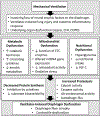Inspiratory Muscle Training in Patients with Prolonged Mechanical Ventilation: Narrative Review
- PMID: 31105474
- PMCID: PMC6521954
- DOI: 10.1097/CPT.0000000000000092
Inspiratory Muscle Training in Patients with Prolonged Mechanical Ventilation: Narrative Review
Abstract
Patients with impending respiratory failure often require mechanical ventilation to optimize gas exchange. Although this form of assisted ventilation is required for survival, its persistent use results in diaphragm weakness and muscle fiber atrophy. There is strong evidence that mechanical ventilation alters the structure and function of the diaphragm, resulting in prolonged dependence on assisted ventilation and long-term consequences such as a delayed functional recovery, reduced quality of life and increased risk of mortality. This review summarizes the mechanisms underlying diaphragm dysfunction due to prolonged mechanical ventilation, highlights the role of inspiratory muscle exercise as a strategy to counter diaphragm weakness, and identifies the parameters of an evidence-supported exercise prescription for difficult to wean patients.
Conflict of interest statement
Notification of Conflicts of Interest: ADM is an external consultant for Lungpacer, which is developing an intravenous phrenic nerve pacing system.
Similar articles
-
Respiratory dysfunction in ventilated patients: can inspiratory muscle training help?Anaesth Intensive Care. 2012 Mar;40(2):236-46. doi: 10.1177/0310057X1204000205. Anaesth Intensive Care. 2012. PMID: 22417017 Review.
-
Critical illness and mechanical ventilation: effects on the diaphragm.Respir Care. 2006 Sep;51(9):1054-61; discussion 1062-4. Respir Care. 2006. PMID: 16934168 Review.
-
Effects of mechanical ventilation on diaphragm function and biology.Eur Respir J. 2002 Dec;20(6):1579-86. doi: 10.1183/09031936.02.00063102. Eur Respir J. 2002. PMID: 12503720 Review.
-
Diaphragm-protective mechanical ventilation.Curr Opin Crit Care. 2019 Feb;25(1):77-85. doi: 10.1097/MCC.0000000000000578. Curr Opin Crit Care. 2019. PMID: 30531536 Review.
-
Assisted mechanical ventilation promotes recovery of diaphragmatic thickness in critically ill patients: a prospective observational study.Crit Care. 2020 Mar 12;24(1):85. doi: 10.1186/s13054-020-2761-6. Crit Care. 2020. PMID: 32164784 Free PMC article.
Cited by
-
From bedside to recovery: exercise therapy for prevention of post-intensive care syndrome.J Intensive Care. 2024 Feb 29;12(1):11. doi: 10.1186/s40560-024-00724-4. J Intensive Care. 2024. PMID: 38424645 Free PMC article. Review.
-
Distinguishing science from pseudoscience in commercial respiratory interventions: an evidence-based guide for health and exercise professionals.Eur J Appl Physiol. 2023 Aug;123(8):1599-1625. doi: 10.1007/s00421-023-05166-8. Epub 2023 Mar 14. Eur J Appl Physiol. 2023. PMID: 36917254 Free PMC article. Review.
-
Evaluation of the Integrative Weaning Index for Predicting the Outcome of Spontaneous Breathing Trial in Patients with Cirrhosis on Mechanical Ventilation: A Pilot Study.Turk J Anaesthesiol Reanim. 2022 Apr;50(2):107-113. doi: 10.5152/TJAR.2021.1057. Turk J Anaesthesiol Reanim. 2022. PMID: 35544249 Free PMC article.
-
Hypotussic cough in persons with dysphagia: biobehavioral interventions and pathways to clinical implementation.Front Rehabil Sci. 2024 Jun 12;5:1394110. doi: 10.3389/fresc.2024.1394110. eCollection 2024. Front Rehabil Sci. 2024. PMID: 38933659 Free PMC article. Review.
-
Sigh maneuver protects healthy lungs during mechanical ventilation in adult Wistar rats.Exp Biol Med (Maywood). 2020 Sep;245(15):1404-1413. doi: 10.1177/1535370220940995. Epub 2020 Jul 8. Exp Biol Med (Maywood). 2020. PMID: 32640895 Free PMC article.
References
-
- Esteban A, et al., How is mechanical ventilation employed in the intensive care unit? An international utilization review. Am J Respir Crit Care Med, 2000. 161(5): p. 1450–1458. - PubMed
-
- Hermans G, et al., Acute outcomes and 1-year mortality of intensive care unit-acquired weakness. A cohort study and propensity-matched analysis. Am J Respir Crit Care Med, 2014. 190(4): p. 410–20. - PubMed
-
- Chelluri L, et al., Long-term mortality and quality of life after prolonged mechanical ventilation. Crit Care Med, 2004. 32(1): p. 61–9. - PubMed
-
- Powers SK, et al., Ventilator-induced diaphragm dysfunction: cause and effect. Am J Physiol Regul Integr Comp Physiol, 2013. 305(5): p. R464–77. - PubMed
-
- Jubran A, Critical illness and mechanical ventilation: effects on the diaphragm. Respir Care, 2006. 51(9): p. 1054–61; discussion 1062–4. - PubMed
Grants and funding
LinkOut - more resources
Full Text Sources

